Shelby GT500 sets iconic standards for 2013
By John Gilbert
A lot of people give nicknames to their favorite cars. “Old Betsy” has given way to a lot of catchier, more contemporary and more personalized monickers. This one could be “Silver Bullet,” or maybe “Blue Streak.” It also could be called outrageous, because in this fuel-economy-conscious era its primary objective is to be mind-boggling fast, every time you touch the throttle, in any of six manually selected gears.
The car in question is the 2013 Shelby GT500, a rocket on wheels that is earthbound, if just barely. The Shelby GT 500 I “owned” for a week-long coexistence was “ingot silver metallic,” with a wide, perfectly contrasting blue stripe running down from its roof, hood and front and rear ends.
Ford claims to have topped 200 miles per hour in in Europe during finishing test runs for this 665 horsepower mind-blower. Others have written that the car won’t go a tick over 198. No sane person, of course, would attempt that unless on a race track, or on a German autobahn in those regions where speed limits are still unlimited. The thrill, for those willing to lay down $60,000 for the ultimate ponycar, is to have the capability, just the potential, to display enormous power every time you turn the key and let out the firm but not-unworkable clutch pedal.
The newest generation of Shelby GT is the latest in a succession of hot-rod Mustangs that were first built by Carroll Shelby, and then recreated to Shelby’s demanding standards back in the late 1960s. To me, the most stunning of them all was the 1969 Shelby GT, which stayed almost the same for 1970, then veered off into other iterations. I admit I’m prejudiced, though, because I owned a 1970 Boss 302 Mustang, and after it got rear-ended and nearly destroyed by a drowsy truck-driver at a rural construction stop, I found a badly treated used Shelby and bought it, then had the sleek body fitted onto the platform and drivetrain of my Boss 302.
The car has moved on, but the name Shelby always retained its magic. I thought that Ford had undercut Carroll Shelby when it developed the Boss 302, and Shelby moved on to other things, working for a new Oldsmobile venture for a while, and employed by Dodge when it built and introduced the Viper. I had met Carroll Shelby when he ran a Trans-Am race team of Mustangs, and I had a wonderful chance to have lunch with him in Dallas, at the Viper introduction. I got Shelby to autograph the white-on-white cap they issued, and I still have it.
Ford lured the aging and infirm Shelby back into the company a few years ago, which was fitting. It was more fitting that the last time I saw Carroll Shelby was only a short time before he died. It was back in November of 2011 in Los Angeles, where this newest generation of Shelby GT500 Mustang was introduced, on the eve of the first media day at the Los Angeles Auto Show.
As befitting Shelby’s style of iconoclastic rebel, that press party was a coup. The assembled media was dazzled that Ford, which had just turned out a cluster of small cars that ran clean and could attain 40 miles per gallon, would unveil a 2013 Shelby GT500 with 662 horsepower and 631 foot-pounds of torque from a revised and supercharged 5.8-liter, dual-overhead-camshaft V8. The coup came the next morning, when Chevrolet had secured an early-morning press gala at the show to introduce its new ZL-1 Camaro. Chevrolet officials understandably gushed about its enormous tally of 580 horsepower and 556 foot-pounds of torque from a supercharged 6.2-liter Corvette V8 — because they didn’t know the car had been upstaged by 82 horsepower and 75 foot-pounds of torque at Ford’s party the night before.
But enough about politicking and posturing, which are clearly the only reasons for either the monster Camaro ZL-1 or the Shelby GT500 even exist. Ford has done great things with the Mustang — the only ponycar that has never gone out of production since its 1965 birth — and the current generation is the best, with exceptional manageable performance from a V6, or a hot-rod power upgrade with a 5.0-liter V8 in the GT, and over-the-top power from a Boss 302 version.
But if there’s a phrase for something that is over and above “over-the-top,” that’s what the Shelby GT500 requires.
The revised front end has a more menacing grille and beady-eyed high-intensity headlights, flanked by a couple of LED bars that lead your eye to the approaching fender housing. The one-piece bumper-fascia is split by the wide double stripe that comes down off the hood and continues below the grille. It’s surprising what designers can do by merely tapering the angles of the headlight housings meeting the sleek sides of the car. Same with the rear, where the taillights slant in just right, on either side of the rear emblem. Each taillight enclosure has three vertical lights on either side, blinking in sequence in case those following are too awed to figure out which way you’re planning to turn.
Without question, fellow drivers and pedestrians take notice when you drive by in a Jaguar XK-R or a Porsche Carrera, or Corvette, but they spend extra time staring after you when you pass in a Shelby GT500. If the flashy paint scheme didn’t catch their eye, with the highly metallic silver beautifully contrasted by the wide, blue accent stripes, the earth-shaking rumble of the enlarged V8, pumped out through dual quad tailpipes, certainly will catch their ear.
My wife, Joan, who enjoys driving high-performance cars, was quick to admonish me for merely starting the Shelby GT500 up after 10 p.m., outside a Minneapolis apartment building, fearing I might wake up the whole building. As it was, Joan doesn’t like ultra-heavy clutches, and the Shelby GT500’s clutch, while it grabs with authority, is not overly heavy to engage. You, however, can make your own judgements about allowing your spouse to take the wheel.
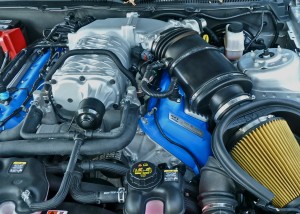
Stretched to 5.8 liters, the DOHC V8 is the most powerful production engine ever built, with 662 horsepower and 637 foot-pounds of torque.
Having played with supercharging its V8 before, Ford turned its SVT (Special Vehicle Team) loose to create the new Shelby GT500. They bored the 5.4-liter V8 out to 5.8 liters, with larger pistons naturally, increased compression ratio and a larger supercharger, with boost increased to 15 pounds per square inch. The SVT guys took some high-performance parts from the Ford GT 2-seater, including camshafts. Enlarging the intercooler more than doubles the amount of coolant that can circulate. My old 1970 Boss 302 engine had an incredible whistle at high RPMs, thanks to a forged steel crankshaft, solid valve lifters, special valves, and a deep-set oilpan, aimed at durability as well as performance. Obviously, engine technology has taken giant leaps over the last 40 years, and SVT has strengthened everything from the crankshaft to the connecting rods, valves, and head gaskets to ensure that the engine will be able to withstand what we in the real world might consider abusive operation. Two engineers do the work on each engine, and autograph a little plate on the engine to verify who did it.
Ford practically demands you push the Shelby GT500, with an optional “launch control” device. This is for optimum takeoff power without melting your Goodyear F1 tires into smoke and leaving black lava stripes on the roadway. What you do is engage the device, then stop, if you’re not already stopped, push down the heavy-duty clutch pedal, then floor the gas pedal. Yes, floor it. The launch control takes over, holding the revs at its predetermined level, and then you simply let out the clutch. No need to sidestep it, or pop it — just let it out. The car launches with great suddenness, electronically coordinating the engine, transmission and clutch to that pivotal crossroads just an eyelash short of smoking the tires, for optimum takeoff traction.
Very impressive, although I must admit I did not try it. I find it intriguing, even fascinating, but to me, any such launches outside a race track or drag-strip reaches across that line into engine abuse. If I bought a Shelby GT500, I’d want it to run happily ever after, and while driving reasonably may not fit the car’s reason-for-being, driving it up to 90 percent of its potential might allow it to live longer than frequently visiting 100 percent.
As impressive as the Shelby GT500 is in going, it is every bit as impressive in its handling and stopping. The suspension has been totally modified, with adjustable Bilstein shock absorbers, stiffer springs, enlarged stabilizer bars front and rear, and a Torsen limited-slip rear differential. That helps the giant Eagle F1 tires — 19-inch front and 20-inch rear — grip the pavement, and actually helps the firmly planted car absorb bumps and irregularities without jarring your fillings loose. The optional performance package includes a console switch that allows you to select normal or sport, and normal was just fine, unless you are on a super-smooth surface, such as a race track.
Brakes are similarly designed to control all that power and handling, with enlarged Brembo disc brakes at all four corners.
exterior is set off with special SVT wheels that add a distinctive touch, and such features continuye inside. Sit in the bucket seats and you appreciate why Recaro is considered the ultimate in aftermarket car seat-making. These genuine Recaros have been designed to be similar in style to the multi-ridged seats of the original. They just grip occupants a lot better, with a comfortably secure posture.The controls are all well-placed, and also show a remembrance to the original Shelby Mustangs. The 220-mph speedometer and tachometer list simple analog digits, and the gear-shift knob is a round white ball.
My only complaint is that I have a physical aversion to artificial fabrics being against my skin. It’s me, I admit, but I get irritated in reaction to phony stuff. In the Shelby GT500, Ford followed the lead of Cadillac, with its CTS-V line, by putting a covering on the steering wheel, just where your left and right hands should be gripping. It would take some convincing for me to believe it’s real suede leather, because it feels like some artificial fuzzy stuff. All I know is that it irritates my hands and also makes them hot — like a heated wheel, or like wrapping your hands in a thermal blanket on a 90-degree day. Give me leather, or solid wood, or normal-but-real real suede leather, just spare me the thermal-fuzzy stuff. Of course, you could buy the car and then peel it off, or replace the steering wheel.
Otherwise, Ford made tasteful use of the original Shelby’s ready-to-strike cobra symbol. When Carroll Shelby first built an AC Bristol sports car and stuffed a Ford V8 into it to dominate sports car racing, it was called a Shelby Cobra. That was before he moved to Ford to build hot-rod Mustangs, where his first cars were Shelby Mustang Cobras, complete with the snake emblem. Displaying the same Cobra in various places in and out of the new car, including original-looking metal snakes on the grille, is a fitting tribute to the car, and the man.
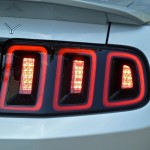
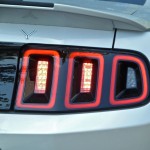

Comments
Tell me what you're thinking...
and oh, if you want a pic to show with your comment, go get a gravatar!


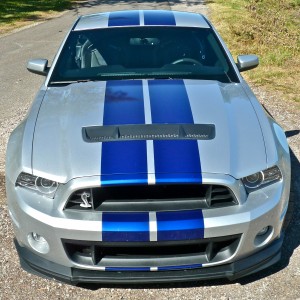
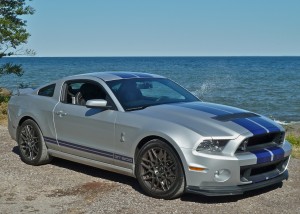
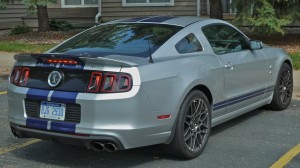
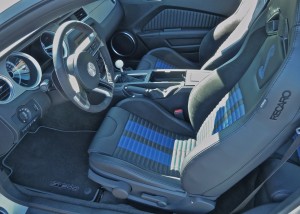

 John Gilbert is a lifetime Minnesotan and career journalist, specializing in cars and sports during and since spending 30 years at the Minneapolis Tribune, now the Star Tribune. More recently, he has continued translating the high-tech world of autos and sharing his passionate insights as a freelance writer/photographer/broadcaster. A member of the prestigious North American Car and Truck of the Year jury since 1993. John can be heard Monday-Friday from 9-11am on 610 KDAL(www.kdal610.com) on the "John Gilbert Show," and writes a column in the Duluth Reader.
John Gilbert is a lifetime Minnesotan and career journalist, specializing in cars and sports during and since spending 30 years at the Minneapolis Tribune, now the Star Tribune. More recently, he has continued translating the high-tech world of autos and sharing his passionate insights as a freelance writer/photographer/broadcaster. A member of the prestigious North American Car and Truck of the Year jury since 1993. John can be heard Monday-Friday from 9-11am on 610 KDAL(www.kdal610.com) on the "John Gilbert Show," and writes a column in the Duluth Reader.